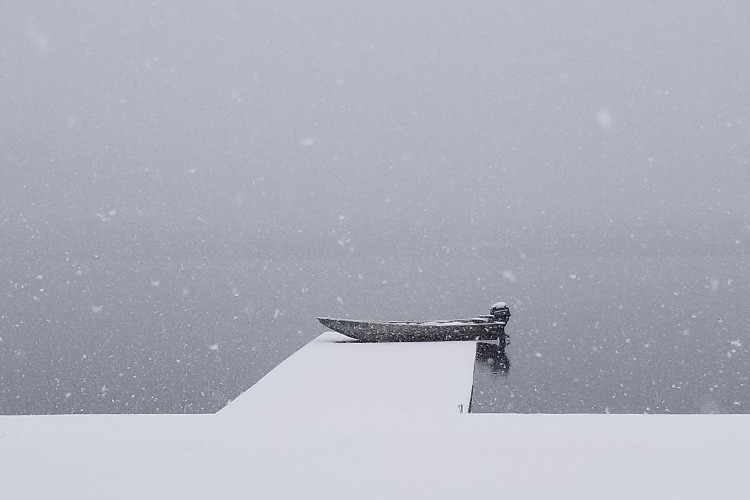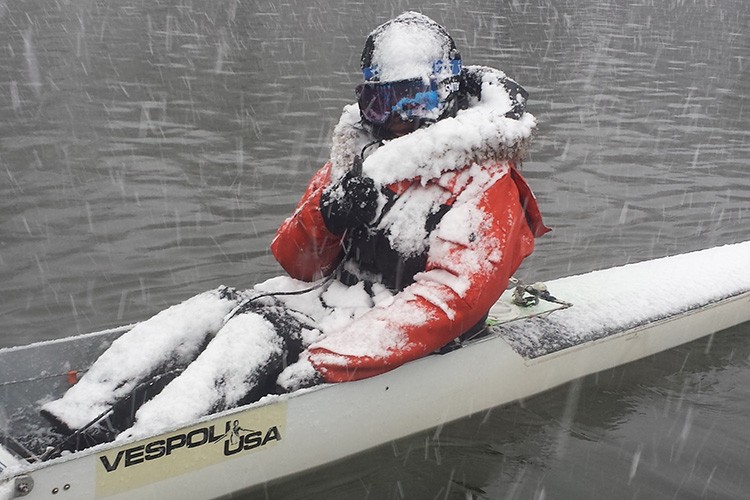Ed Hewitt, row2k.com

Here in the northern reaches of the northern hemisphere, many rowers are settling their equipment down for a long winter's nap. But as the December and January holidays approach, even crews with perfect weather (perhaps at southern latitudes in the northern hemi, and throughout the southern hemi, schools getting out for the summer, etc.) may be putting their equipment into drydock for a spell at some point.
During day to day use, the stresses and strains that are put on a boat can actually help to safeguard it by keeping salt and other minerals at bay - but when they sit on racks for days and weeks, the chemical processes get to work.
Even if you don't row on salt water regularly, equipment may be exposed to damaging substances, whether while trailering, during training trips or races on brackish water, and in other ways. Here are tips on winterizing, summarizing, and just prepping your equipment ahead of downtime at any time of year.
Boats
- Clean all boats, with emphasis on the following.
Cleaning your equipment well is a self-evident tactic, but there are a few things to focus on. In particular, focus on anything that could fester when the boat stops moving for a while.
"Make sure that anything that is caked on there – any salt, or any corrosion, or anything like that – doesn't have a chance to set in while the boat is just sitting there," Alex Selvig, president of Elite Rowing, Inc., Filippi importers for the USA, said.
Pay close attention to areas where metal touches other metal, or where bolts go through ribs or places where they could seize up.
- Move or remove bolts and screws.
Most rowing folks have seen bolts that are frozen in place; Selvig says this is a good time to prevent that. "It is good to take all the bolts out, all the screws out, and clean them all up again." In some cases you can just slip them out, have a look, and put them back where they were; making sure they are easy to move and not starting to corrode is the main task."
Selvig recommends two products to clean and preserve hardware: TEF Gel or Lanocote.
"What I think is the best is called TEF Gel," he said. "It's super sticky, and prevents walling and galvanic corrosion with similar metals. It's not cheap, but it can definitely save you a lot of money in the long run. A cheaper alternative is Lanocote; they’re both sticky, and won’t wash off. They’re hard to remove from your hands but they're great, great products, and well worth it, and almost mandatory in saltwater.
- Take riggers off the boat, and store them in a heated area.
Especially if you have aluminum riggers that have 'weep holes' that allow water to escape, you will want to store your riggers away from freezing temps."You're never going to really get all that water out of there, and it could be dangerous if water inside the riggers freezes up, which could potentially crack the tubes from the inside. If at all possible you store your riggers in a heated area," he said.
- Move and clean the tracks.
"One place where water generally will pool is on the underside of the tracks," Selvig said "If the boat's upside down, that water's going to stay there, and could be a problem. At a minimum, just make sure you slide the tracks fore and aft as far as they will go in either direction to break up anything, dry them out, and you should be okay." - Check for water under decks and in bow and stern sections.
"In some conditions some boats tend to collect a lot of water, and you want to get all of it out of there. If your boat is upside down, you can generally just drop a towel in there and let it sop up any water, that will usually be enough." - Sectional boats.
For crews in places that do not have to take sectional boats apart to travel, Selvig recommends leaving the boats fully assembled.
"We leave them together because the original barrier grease that is in there will still be there."
For crews in locations where traffic laws require that they take their boats apart for transport, Selvig recommends cleaning the grease from the two faces of the joints so that dust and debris do not stick. From there, most of the above tactics apply - make sure to clean up any corrosion, replace parts that are showing wear, and make sure everything still moves before storing.
- Avoid critters.
When taking a double off the rack for the first row of the year a couple years ago, as he was holding the boat overhead, a squirrel sprinted down my doubles partner's arm, across his neck, down his chest, and jumped onto the ground. He held the boat tight and let the squirrel take off, then started to walk out of the boat tent - and another one did the same thing. Selig recommends preventative steps to avoid critters nesting in your boat, which can cause damage as they chew up shoes, dirty things up, and can be dangerous if cornered.![]()
"You may want to put stuff inside the shoes so the birds and other animals don't make nests in there," Selvig said. "Maybe put a plastic bag over the shoes if you get a lot of wildlife running around."
CoxBoxes and other Electronics
Joe Racosky, Sustaining Product Manager at Nielsen-Kellerman, shares the following best practices for electronics such as Cox Boxes, wiring, and oarlocks.

"The main concerns around off-season storage remain around the battery," Racosky said. "Since most of our products use Lithium-Ion batteries, the guidance is similar."
Racosky sent the following punch list:
- Make sure you store the units in a dry, moderate temperature location. We don't recommend either very cold or hot temperatures for storage.
- Store the units at about half discharge for the battery. Anywhere from 40-60% charge is optimal for storage.
- If you are storing for more than two months, it is recommended to recharge the battery back to the half charge range - check at around the two-month mark and give it a partial charge as necessary. We don't want the battery to get super low in the off-season.
- Don't keep them on charge continuously.
- For CoxBoxes, it is good practice to clean out the connectors before storage using something like our Audio Maintenance Kit.
For the in-boat wiring, Racosky recommends the following:
- Inspect the wiring for any tears or cracks that may lead to issues in the future. Re-tighten any loose connections or zip-tie areas that may have become undone.
- If using Empower Oarlocks, remove the battery.
- Keep all the wiring from being exposed to rain/snow. The storage temperature is not as important but be careful when bending or manipulating the wiring in colder conditions as it can be more brittle.
- Clean the connector that goes into the CoxBox with alcohol and add some Nyogel.
- Clean any of the SpeedCoach mounts that have wiring with alcohol.
- If any boats are having audio issues, now is a good time to systematically go through piece by piece with "known good" equipment to isolate where the issue might be.
Oars
Oars are arguably less sensitive than some other equipment, but there are still best practices for keeping your oars in good shape to be ready when you return to rowing. Meredith Breiland of Concept2 marketing offers the following tips:
- Inspect for blade dents, shaft cracks, or water in the shaft. Feel for soft spots on the shaft; this could indicate invisible cracks. Clean the oars, and don’t neglect oarlocks; keep them clean and grit-free.
For water in the oar and other problems, any repairs may depend on the age of the oar and a few other factors, so call the oarmaker if you have concerns and they can help troubleshoot problems and help discuss repair options.
- Clean handles and grips. Let them air dry at room temperature before storing away for winter. Any grips showing discoloring or signs of wear should be replaced.
- The off-season is a great time to rotate sleeve collars; C2 collars have a symmetric design so you can extend their overall life by using both sides (Croker collars can be flipped to the other side of the boat, and other oars may have similar options).
- Rinse equipment after every use and before long-term storage. Pay special attention to sleeves, collars and oarlocks. In salt water environments, take extra care to rinse, dry and protect from the elements. Even the air near the ocean is harsh on your equipment. Store indoors or covered.
- Store oars and sculls in racks with the handles up, when possible.
- Oars can be stored (and rowed) at low temperatures during winter months; feel free to leave your equipment at the boathouse, if secure. (Note your oar serial number in a safe place for easy identification.)
- In salt water environments, take extra care to rinse, dry and protect from the elements. Even the air near the ocean is harsh on your equipment. Store indoors or covered.
- Do not store your oars long-term in continuous sunlight. Ultraviolet light will eventually degrade the surface and shorten the life of the oar.
- Order spare parts and oars early so you’re prepared when spring arrives - lead times often increase during the sprint season when teams and crews are eager to start practicing and racing again.
If you enjoy and rely on row2k, we need your help to be able to keep doing all this. Though row2k sometimes looks like a big, outside-funded operation, it mainly runs on enthusiasm and grit. Help us keep it coming, thank you! Learn more.
Comments | Log in to comment |
- Bont Rowing
- Calm Waters Rowing
- Concept 2
- Craftsbury Sculling
- The Crew Classic
- CrewLAB
- Croker
- Dad Vail Regatta
- Durham Boat Co.
- Empacher
- Faster Masters
- Filippi
- Fluidesign
- h2row.net
- HUDSON
- Live2Row Studios
- Nielsen-Kellerman
- Oak Ridge RA
- Peinert Boat Works
- Pocock Racing Shells
- Race1 USA
- Rockland Rowing Masters Regatta
- RowKraft
- Rubini Jewelers
- Vespoli USA
- WinTech Racing
- Bont Rowing
- Calm Waters Rowing
- Concept 2
- Craftsbury Sculling
- The Crew Classic
- CrewLAB
- Croker
- Dad Vail Regatta
- Durham Boat Co.
- Empacher
- Faster Masters
- Filippi
- Fluidesign
- h2row.net
- HUDSON
- Live2Row Studios
- Nielsen-Kellerman
- Oak Ridge RA
- Peinert Boat Works
- Pocock Racing Shells
- Race1 USA
- Rockland Rowing Masters Regatta
- RowKraft
- Rubini Jewelers
- Vespoli USA
- WinTech Racing



















12/18/2019 4:23:32 PM